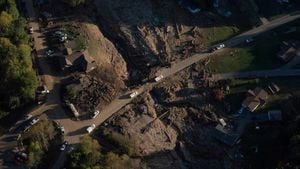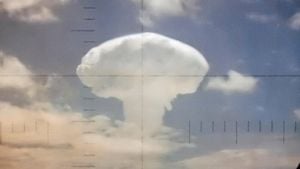A spectacular surge in solar activity is enchanting skywatchers across the globe, as the Northern Lights, also known as the aurora borealis, grace the night skies with their vibrant colors. Typically confined to the polar regions, this dazzling light display is now becoming visible at lower latitudes, offering rare opportunities for enthusiasts and casual observers alike.
According to the latest forecasts from the National Oceanic and Atmospheric Administration (NOAA), parts of northern Montana, North Dakota, and Minnesota stand the best chance of witnessing this stunning celestial phenomenon on Tuesday night. The auroras are expected to appear as bright greens and ethereal pinks, painting the heavens with breathtaking colors.
But it's not just these northern states. The forecast also suggests lower chances of visibility reaching as far as parts of Washington, northern Idaho, South Dakota, Wisconsin, Michigan, and Maine. Those hoping to catch a glimpse of the lights should position themselves away from urban light pollution. The optimal window for viewing is between 10 p.m. and 2 a.m. local time, during which the dark sky offers the best backdrop for the auroras.
This year’s aurora forecast arises primarily from increased geomagnetic activity driven by intense solar flares emanated from the Sun’s surface. Such flares release immense bursts of energy, which interact with Earth's magnetic field and atmosphere, producing those mesmerizing light displays associated with the Northern Lights.
NOAA elaborates on the conditions necessary for visibility: "Although the auroras predominantly dance around the magnetic poles of the Earth, clear skies and low light pollution can allow observers to see the vibrant colors extending significantly away from those areas. On particularly active nights, the aurora can even be seen hundreds of miles away from the polar regions, making the skies accessible for many more individuals than usual. "
While the stunning display captivates many, it's also important to note the scientific background behind these phenomena. The nearing solar maximum, anticipated between 2025 and early 2026, signifies the peak of the Sun’s 11-year solar activity rhythm. This peak is expected to bring about more frequent solar flares and coronal mass ejections, increasing the likelihood of the Northern Lights gracing areas not typically accustomed to them. People living at lower latitudes might soon find themselves treated to spectacular views of the aurora, something they may not have previously considered possible.
For those planning to photograph this extraordinary event, tips abound to help capture the elusive lights on camera. Experts recommend using devices equipped with night mode or making adjustments on professional cameras. Essential settings involve setting low shutter speed, increasing ISO, and utilizing the widest aperture possible to encapsulate the rich colors and movements of the aurora.
Adding to the celestial charm this week is the Taurid meteor shower and November's supermoon, creating substantial opportunities for stargazers to revel in nature's wonders. This atmospheric alignment makes it one of the best weeks of the year for observing various astronomical phenomena, and certainly, the Northern Lights are the dazzling cherries on top.
For anyone wishing to catch these extraordinary displays of beauty, it's wise to consult local cloud cover forecasts for clear pitching spots, as auroras tend to shine brightest against unclouded skies. The ambiance surrounding these moments is equally enticing, to sit under the expanse of night filled with shimmering lights, making for not just visual, but emotional escapades.
Skywatching isn’t just about the display itself, though; it’s also about community and sharing the experience with friends and family. The magic of the Northern Lights brings people together, turning ordinary nights under the stars extraordinary.
Although auroras tend to be most frequent closer to winter, this current uptick due to solar activity promises more sightings across many geographical areas. Enthusiasts have been anticipating and preparing for this event, with many travel companies even offering specialized northern lights tours, encouraging people to venture out to witness the amazing display live.
Even as we embrace these beautiful scenes, the science behind the Northern Lights, particularly as we approach maximum solar activity, reveals much about our sun's habits and its influence on Earth. Scientists are tuned closely to solar measurements and their effects on Earth's magnetosphere, which play significant roles not just for astronomers and stargazers, but also for national power grids and communication systems.
The excitement and exploration don’t stop there, though. This week’s events prompt conversation on space weather and the way it can alter our planet's environment. Visibility of the Northern Lights can lead to discussions about climate patterns and their changes due to cosmic events, how they affect daily life, and what they might mean for the future.
Natural occurrences like these create awe among us, prompting us to reflect on our connection to the universe. The Northern Lights stand as ephemeral artworks painted across the sky, evoking wonder and joy, serving as reminders of nature's beauty and mystery. They inspire us to look up and ask questions about our place within the grandeur of the cosmos, and they compel us to seek out more than just plain life—we are driven to explore, to wonder and relish encounters with the unknown.
With this recent upsurge of solar activity marking the beginning of more vibrant displays, the anticipation surrounding the Northern Lights is only set to grow. For many, this presents the perfect chance to experience the thrills of nature's light show, so grab your jackets, head outside, and immerse yourself under the mesmerizing glow of the auroras!
Stay tuned to local weather reports and aurora forecasts as we enter what promises to be another exciting chapter of celestial exploration filled with captivating displays and countless reasons to be inspired by our universe!



